What Did Leonardo da Vinci Invent?
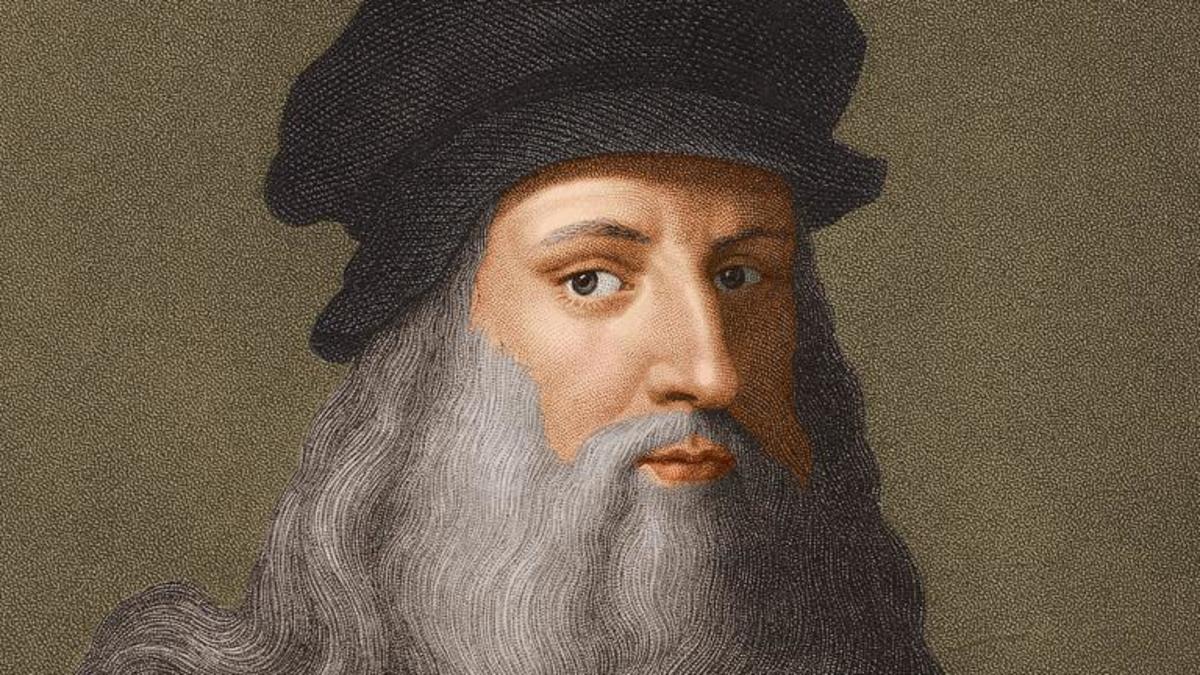
6 min read ⌚
Who Was Leonardo da Vinci?
Look up the word “polymath” in the Dictionary, and you’ll end up reading a biography of Leonardo da Vinci!
Don’t believe us?
Here’s what Wikipedia says a “polymath” means:
A polymath (Greek: πολυμαθής, polymathēs, “having learned much,” Latin: homo universalis, “universal man”) is a person whose expertise spans a significant number of different subject areas—such a person is known to draw on complex bodies of knowledge to solve specific problems.
And here are the first two sentences of Wikipedia’s article on Leonardo da Vinci:
Leonardo di ser Piero da Vinci, more commonly Leonardo da Vinci or simply Leonardo, was an Italian Renaissance polymath whose areas of interest included invention, painting, sculpting, architecture, science, music, mathematics, engineering, literature, anatomy, geology, astronomy, botany, writing, history, and cartography. He has been variously called the father of paleontology, ichnology, and architecture, and is widely considered one of the greatest painters of all time.
So, to answer your question:
“Who was Leonardo da Vinci?”
He was the original polymath, the archetype of the Renaissance man, a guy so smart and capable that his resume would have probably given you an inferiority complex just by the sheer number of pages.
Speaking of which –
Leonardo da Vinci: An Exceptional CV
We know you know him as the painter of the “Mona Lisa” and “The Last Supper” – two of the greatest paintings ever sketched by a man’s hand – but, in the case of Leonardo, that is basically the same as saying that LeBron James is an average streetballer.
In other words, painting masterpieces was merely one small aspect of what Leonardo was good at.
Case in point:
In 1482, when he was 30 years old and jobless, he penned his own CV and sent it to Ludovico il Moro, Duke of Milan, in the hope that it will get him a gig or two.
It’s merely 11 points long, but it will make your head spin and your confidence vaporize in thin air.
The letter says, in no immodest terms, that its author is capable of – in the original order –
1. building indestructible – extremely light and strong – and easily carriable (what?!) bridges;
2. taking the water out of the trenches when a place is besieged;
3. modeling machines which will easily destroy other places;
4. creating storm-mimicking mortars;
5. building indestructible vessels;
6. devising noiseless mines;
7. inventing safe and unattackable chariots;
8. creating big guns of any type already in existence;
9. contriving “catapults, mangonels, trabocchi, and other machines of marvelous efficacy and not in common use.”
So, basically, if there’s a war and you have Leonardo on your side, it’s not much more different than finding out about the “iddqd” and “idkfa” cheat codes and using them both at the same time in “Doom.”
With da Vinci, you end up having all the weapons and being basically indestructible.
Wait… wasn’t Leonardo the guy who painted Mona Lisa?
Didn’t he know how to paint before he was 30?
If so – why doesn’t he mention that in his CV?
Oh, yeah – we forgot that: he mentions his peace-time qualities in the last two points of his resume, as if in passing:
10. In times of peace I believe I can give perfect satisfaction and to the equal of any other in architecture and the composition of buildings public and private; and in guiding water from one place to another.
11. I can carry out sculpture in marble, bronze, or clay, and also I can do in painting whatever may be done, as well as any other, be he who he may.
The point?
Leonardo da Vinci, one of the greatest artists in history, was architect and sculptor and painter only when there was not much to do around.
And when there was – well he was inventing the hell out of everything.
Here are the top 5 Leonardo da Vinci inventions, in the order of “awesome” to “downright godlike”!
What Did Leonardo da Vinci Invent: Top 5 Leonardo da Vinci Inventions
#5. Self-Propelled Cart
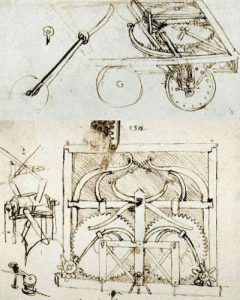 Or, to put it in one word – a car.
Or, to put it in one word – a car.
Leonardo was often thinking about things people would only start thinking about in the 20th century. To make this even more fascinating: in this case, he was probably just imagining a device for theatrical use.
And what he came up with was a cart able to move without being pushed by anyone!
Which makes us think: if someone had asked Leonardo back in the 15th century to do his homework, would Leonardo write him a doctoral dissertation instead?
We forgot to mention: no one knew what the painting on the left was until about two decades ago when Italy’s Institute and Museum of the History of Science in Florence developed a working model based on that image.
And it actually worked!
#4. Robotic Knight
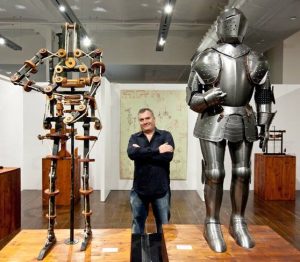 You read that right!
You read that right!
What you’re looking on the left is a 2002 version of Leonardo da Vinci’s 15th-century idea of what a robotic knight may look like.
Unsurprisingly, the prototype – created by NASA’s roboticist Mark Rosheim – was able to both walk and wave.
And that’s not even the fascinating part:
Mark Rosheim commented how da Vinci’s design featured not one unnecessary part!
So – both futuristic and efficient.
#3. Helicopter (and Other Flying Machines)
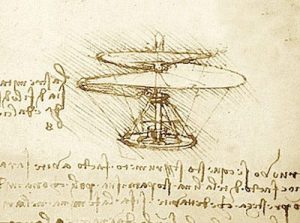 One of the things Leonardo da Vinci was most interested in when it came to inventions was flying.
One of the things Leonardo da Vinci was most interested in when it came to inventions was flying.
So, he spent a lot of time looking at birds and analyzing their flight. About 1505 he even composed a short treatise called “Codex on the Flight of Birds.”
And he did many different sketches of flying machines, whether ornithopters or helicopters.
Watch here modern scientists testing them one by one:
Now, most of Da Vinci’s flying machines didn’t work.
But next to the image on the left (called the aerial screw), he jotted down this observation:
If this instrument made with a screw be well made – that is to say, made of linen of which the pores are stopped up with starch and be turned swiftly, the said screw will make its spiral in the air, and it will rise high.
#2. Parachute
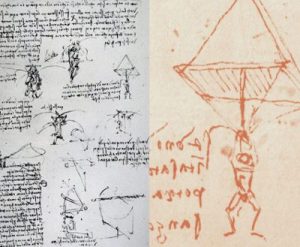 People were still unable to even fathom a concept such as a flying human, and da Vinci was already working out a device designed for a safe landing.
People were still unable to even fathom a concept such as a flying human, and da Vinci was already working out a device designed for a safe landing.
And unlike the flying machines which needed some fine-tuning to work, Leonardo’s pyramidal parachute would have worked the way it was sketched just perfectly.
Making Leonardo the official inventor of the parachute!
That was set in stone in July 2000 when Adrian Nicholas successfully tested a modern model of Leonardo’s half a millennium old design.
But, just in case, his Swiss colleague Olivier Vietti-Teppa verified the findings eight years later.
#1. Tank
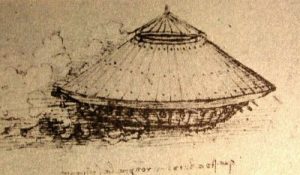 When Leonardo was saying that he’s capable of building indestructible vehicles, he wasn’t you claiming that you know Mandarin Chinese on your CV because, well, who does to check that?
When Leonardo was saying that he’s capable of building indestructible vehicles, he wasn’t you claiming that you know Mandarin Chinese on your CV because, well, who does to check that?
Oh, no – Leonardo was dead serious!
In other words, he had devised in his mind the precursor to the modern tank, and that’s his version of it on the left.
It could move in any direction and fire from a number of circularly placed light cannons.
However, it had to be powered by the crew of eight men.
Now, Leonardo didn’t have much time to play around with his designs – you know being busy with, well, absolutely everything.
But, people note that if he had, he would have certainly realized that he could combine #5 and #1, changing the history of warfare in a way we can’t even imagine!
Like this summary? We’d like to invite you to download our free 12 min app, for more amazing summaries and audiobooks.
“Leonardo da Vinci Quotes”
Painting is poetry that is seen rather than felt, and poetry is painting that is felt rather than seen. Share on X A painter should begin every canvas with a wash of black because all things in nature are dark except where exposed by the light. Share on X Once you have tasted flight, you will forever walk the earth with your eyes turned skyward, for there you have been, and there you will always long to return. Share on X Study without desire spoils the memory, and it retains nothing that it takes in. Share on X It had long since come to my attention that people of accomplishment rarely sat back and let things happen to them. They went out and happened to things. Share on XWhen Did Leonardo da Vinci Die?
Now, unfortunately, Leonardo da Vinci wasn’t immortal – though, we bet that he was working on something of this sort somewhere in his notebooks; prepare to find out about it in a century or so.
Even more tragically, he died in 1519, at barely 67 years of age, having left behind him the work of about four highly talented centenarians.
According to Helen Gardner, he was a man of “unquenchable curiosity” and “feverishly inventive imagination” with a “mind and personality [which] seem to us superhuman.”
“There had never been another man born in the world who knew as much as Leonardo,” said Benvenuto Cellini, a great sculptor, some 20 years after Leonardo died.
Five centuries later, we add: and probably there never will be.








